News
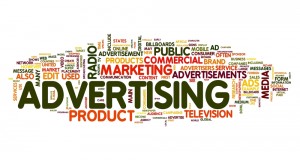 Based on the digital evolution, advertising has moved on from print only to multimedia formats targeted at specific audience sectors. In today’s marketing and advertising, brands include content that are informational, non-intrusive and entertaining for they are aware of what their consumers are looking for. The companies vying for attention of the users comprehend the fact that it is important to not only follow the latest trends, but be the ones to start them.
Based on the digital evolution, advertising has moved on from print only to multimedia formats targeted at specific audience sectors. In today’s marketing and advertising, brands include content that are informational, non-intrusive and entertaining for they are aware of what their consumers are looking for. The companies vying for attention of the users comprehend the fact that it is important to not only follow the latest trends, but be the ones to start them.
Wanting to increase their brand recall value among the consumers, companies are actually coming up with campaigns that are interactive and more immersive in nature, especially with their direct target audience. While the content has become more liberal in nature, these brands have been successfully able to build brand visibility. Remember Anouk’s advertisement series “Bold is beautiful” that showed homosexuality with in the backdrop of India? This can be seen in the Anouk’s ad itself, where on one hand, it dealt with a sensitive issue in a land where same sex love is still unacceptable, and on the other hand, the brand was able to create a connection with their target audience, women of all ages. Another example is that of 2015’s Super Bowl XLIX experiential event where Bud built a 75,000 square foot “House of Whatever” structure. While the event was invitation only, the participants had to prove that they are “up for whatever” which also included making spontaneous videos of drinking Bud Light and using the hashtag #upforwhatever for Tweets.

The brands are creating unique and personal content that is shared across all online and offline platforms. These brands are moving towards a two-way relationship between companies and consumers, and this is occurring across all platforms - from Tumblr to Instagram, to taxis, buses, and storefronts. As time passed, brands have slowly understood the importance of building conversations around their area of expertise. For example, Budweiser created a craft beer video, which would generated awareness about drinking and driving. It did so without featuring alcohol or graphic car crash images, but just a worried dog. It was released on the America’s 5th Annual Global Be (er) Responsible day and encouraged viewers to share the video using hashtag #FriendsAreWaiting. Seeing the response it got in Youtube, smaller brands also picked up the trend and started churning out advertisement plans which were interactive and had great content. Another example, this time from the hair conditioner market, is that of Dove (Unilever) which was supposed to be a comment on how women perceive themselves and went on to urge women to embrace themselves.
 Besides the changes in online video advertising, adverts of today are also catering to consumers who are always on the go. These target audience sport the smartwatches and the wearable devices which are actually posing to be a challenge for most brand’s marketing campaigns. The ad executives are looking at content for their brands that would be concise, useful and entertaining. The standout mobile marketing app is Chipotle’s the Scarecrow app that promotes their “food with integrity” campaign.
Besides the changes in online video advertising, adverts of today are also catering to consumers who are always on the go. These target audience sport the smartwatches and the wearable devices which are actually posing to be a challenge for most brand’s marketing campaigns. The ad executives are looking at content for their brands that would be concise, useful and entertaining. The standout mobile marketing app is Chipotle’s the Scarecrow app that promotes their “food with integrity” campaign.
With the availability of consumer behavior database, targeting has improved immensely, enabling presentation of ads to the target audience. To cite an instance, online shoppers looking for high priced shoes would automatically see ads for Steve Madden, Louboutin and Dolce and Gabbana. This understanding of consumer behavior has actually helped brands understand what does and what does not work for them, enabling them to market products accordingly.
Using modern communication offers greater level of interactivity without making anybody feel that they are being sold anything. This way, brands are giving something to interact with, rather than a simple content to be watched or listened to. The big brands like Coca-Cola are creating marketing campaigns that include innovative ways to get their message across to the consumer and create brand loyalty.
Posted on August 3, 2015
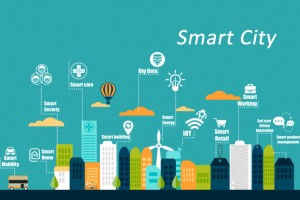 Smart cities capitalize on new and existing technologies and insights derived from collected data to transform their way of operation and service deliveries. Engineers work hard – rewiring and reprogramming the city’s infrastructure – to provide the city’s residents with improved quality of life and dynamic economic climate. However, these cities also face monetary, resource, security and legal constraints that frequently change the objectives of the smart city. This means that only with proper collaboration, planning and application can residents actually help identify opportunities and reap benefits from them.
Smart cities capitalize on new and existing technologies and insights derived from collected data to transform their way of operation and service deliveries. Engineers work hard – rewiring and reprogramming the city’s infrastructure – to provide the city’s residents with improved quality of life and dynamic economic climate. However, these cities also face monetary, resource, security and legal constraints that frequently change the objectives of the smart city. This means that only with proper collaboration, planning and application can residents actually help identify opportunities and reap benefits from them.
Experts predicted that urban population would be doubled by 2050, which would mean that the existing cities will need to become smarter to be able to handle this rapid urbanization and all the challenges that come with it. Smart cities are, therefore, built with smart intelligent infrastructure systems, such as smart grids, security solutions, building automation and traffic control systems. All this integrated technological innovation help in improving the economic and environmental conditions of the city. Understanding the benefits of smart cities and its acceptability to the urban population globally, leaders all around the world are desperately trying to build such cities. The latest to join this bandwagon is the Indian subcontinent wherein Mr. Narendra Modi, India’s PM, announced his vision of setting up 100 smart cities across the country.
Technologies used to build smart cities
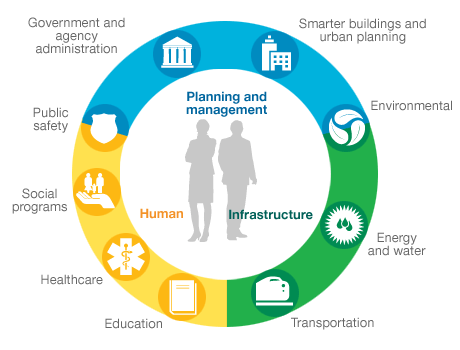
Smart cities use technologies that foster green development, innovation and new citizen participation. Market experts think that innovative concepts that deal with energy and climate change, open government, sustain mobile environment and urban resilience are needed to build a smart city. As Internet users double across the world and the peer-to-peer connectivity strengthens, smart cities become more of a “live” ecosystem wherein connected networks and nodes capture and strengthen real time activities of individuals. The insight and data generated and analyzed here would ultimately enable the citizens of smart cities to thrive optimally.
All smart cities embrace a comprehensive approach in attaining their objectives so that sustainable development is in place and persistent challenges are addressed. To cite an instance, Toronto’s waterfront development embodies this principle to provide flood protection to the area and thereby unlocks significant economic developments.
Integrating technologies like Web 2.0, social media platforms, advanced analytics and access to public data would help in improving services for everyone in a smart city. To cite an instance, use of portable medical devices in the healthcare sector would allow healthcare professionals to access information of patients in real time and enable seamless decision-making. This communication and connectivity between machine and humans would help in leveraging capacities across all infrastructures. The benefits do not end here. Streamlined connectivity is also expected to transform education systems and ability to access information for all stakeholders in the city. Furthermore, collaborative platforms, cloud, and technologies like robotics, AI, 3D printing would also have profound effects on the quality of life of settlers in the smart city.
Are smart cities vulnerable?
Security experts fear that the connectivity existing in smart cities make them vulnerable to cyber-attacks. Market experts on video surveillance equipment argues that existence of wireless sensors that controls everything from healthcare to traffic to the functioning of the government, can actually make a city stop functioning when hacked into, wreaking havoc everywhere.
This is not a hypothetical threat. Extensive research on the technologies used by smart cities have actually discovered hacking groups that targeted power networks across the US and Europe. If the city can be easily hacked into and security problems created everywhere, the smart city would cease to remain “smart” and become a “dumb” one. Therefore, leaders need to start devising and implementing solutions to provide security just as a corporate network might.
Even if smart city is comparatively a new concept for man, it cannot function in isolation. Smart cities can only be successful when all stakeholders collaborate and contribute effectively for creation of an efficient smart city. This means that the recipe for building and sustaining such a city needs to be correct for it to be successful. This can only be done when all the integrated technology in use are secure, and stakeholders of the city are interested in building a sustainable environment. Only then would the smart city grow and give something to everyone. As Canadian journalist Jane Jacobs wrote, “Cities have the capability of providing something for everybody only because and only when they are created by everybody.”
Posted on July 24, 2015
 Increased smartphone proliferation has completely revolutionized the media and entertainment sector. Research states that by 2020, on an average, 80% of smartphone users would access or stream video and digital content only on their mobile devices. Moreover, users would actually spend two to three dollars on internet services for their mobile and not any fixed line. All these indicate that media and entertainment industry should embrace the online digital medium completely.
Increased smartphone proliferation has completely revolutionized the media and entertainment sector. Research states that by 2020, on an average, 80% of smartphone users would access or stream video and digital content only on their mobile devices. Moreover, users would actually spend two to three dollars on internet services for their mobile and not any fixed line. All these indicate that media and entertainment industry should embrace the online digital medium completely.
With the rampant increase in applications and fall in prices of mobile devices, the overall mobile internet subscription is also expected to increase from 7.1 billion in 2014 to 9.2 billion by 2020. Moreover, it is not just smartphone penetration that is increasing; research has found that consumers are actually spending more time using them.
All these data point to the simple fact that even the most ordinary of people are actually sharing, discussing, filtering, and even compiling information instantly using the internet. This has actually affected the media and entertainment industry in a profound manner, especially when it has been established by research that by 2017, more than half the world would be connected through the internet.
 This rise in the use of smartphone and birth of the connected users have changed a few things. To cite an instance, digital content creation and sharing has evolved according to the present consumer habits. The connected devices have enabled consumer’s ability to choose how, when and where they want to access news, films, music, videos and books. This change in habits and preferences of consumers have led the major media groups to innovate and adapt their businesses accordingly to the consumer behavior patterns.
This rise in the use of smartphone and birth of the connected users have changed a few things. To cite an instance, digital content creation and sharing has evolved according to the present consumer habits. The connected devices have enabled consumer’s ability to choose how, when and where they want to access news, films, music, videos and books. This change in habits and preferences of consumers have led the major media groups to innovate and adapt their businesses accordingly to the consumer behavior patterns.
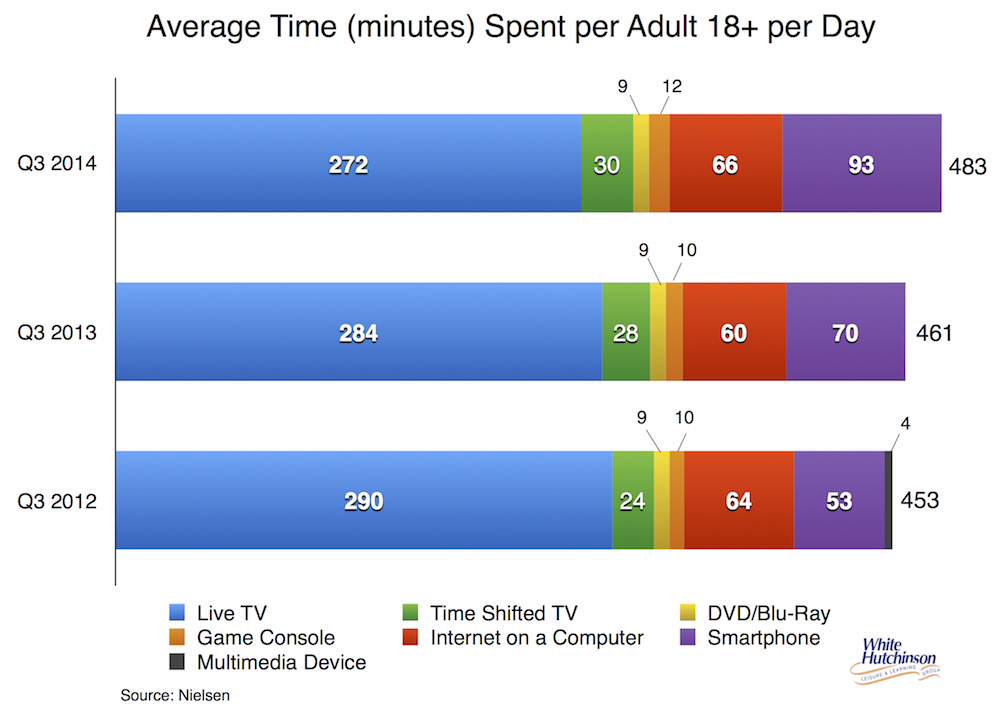
As per market experts, currently, the media content subscription is facing the same issues which the music industry faced in the last decade. The music industry moved from album sales to singe track downloads or streaming services after analyzing customer’s preferences. Both content and pay TV subscription is now following the same avenue and providing content as and when needed by the user. However, the media and entertainment industry seriously hopes that their target audience would agree to pay a little more for their favorite shows, especially with this new viewership model. Also, the TV industry thinks that this shift to watching content on mobile devices will help in shifting the share of advertising revenues from broadcast channels to digital mediums.
Besides these changes in the form of viewing content and sharing advertisement revenues, market research on mobile entertainment market predicts that in the future, social media platforms would drive popularity of content. Viewership of different content and social networking would become a parallel activity. For instance, users would be able to view music videos and enable music subscription services directly from the app. Furthermore, preinstalled mobile wallets would allow making payments in variety of currency types (including Bitcoins). The payment schemes could also have their social system like the Apple’s iTunes store, which allows users to post influential reviews and recommendations about applications.
Every day there are glaring signs of traditional forms of media and entertainment declining and the digital format gaining preference among the target audience. To cite an instance, book retailer, Borders, dropped its shutters mainly because individuals, today, have the power to publish and market their own books in digital formats. However, this does not mean printed books are dead. It’s just that the industry is evolving faster and adopting new trends. The same is true for the media industry. The broadcast channels won’t disappear, but the producers would ensure that their content is available across all possible media formats for their target audience. Different media companies are capitalizing on the available social media platforms, wherein the stakeholders of media and entertainment sector are interacting directly with their target audience.
No one can predict the future, but analyzing the consumer viewing trends can actually lead the media sector to adopt these changes and transform their format for creating and sharing content. With an increasing number of smart devices entering the market, the media and entertainment sector should take these changing realities in their stride, act accordingly, and act fast.
Posted on July 20, 2015
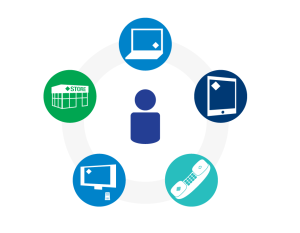 A lot has changed in the last decade. The one field where the impact of these changes have been felt the most is communication. Advancements in the field of technology and communication have changed our perception and methods of connecting with the world around us. With this, there has also been an evolution in the way businesses formulate their strategies. While the adage ‘the customer is always right’ has been around for ages, the ability to always stay connected have taken that to a whole new level. In an age and time where it takes less than a minute to besmirch the reputation of a company, organizations, now more than ever, are paying increased attention to what the consumer has to say.
A lot has changed in the last decade. The one field where the impact of these changes have been felt the most is communication. Advancements in the field of technology and communication have changed our perception and methods of connecting with the world around us. With this, there has also been an evolution in the way businesses formulate their strategies. While the adage ‘the customer is always right’ has been around for ages, the ability to always stay connected have taken that to a whole new level. In an age and time where it takes less than a minute to besmirch the reputation of a company, organizations, now more than ever, are paying increased attention to what the consumer has to say.
Any business venture worth its name has to take into account the impact that connected consumers can have on their business. This is especially true in case of the retail sector. With the growing rate of penetration of smartphones, one no longer needs to go shop-hopping to find the best price. They can check out the pricing offered by all the shops in the neighborhood while standing within the premises of a single store. As a matter of fact, research on global markets has shown that over 50% of consumers search for products on their mobile phones while inside the premises of a shop. It is of little wonder that a majority of the businesses have a dedicated mobile app. Some platforms have even gone so far as to ditch their desktop presence altogether and go only for the mobile app version. These apps invite inputs from customers – both about their experience when using the app as well as when conducting business with the company.
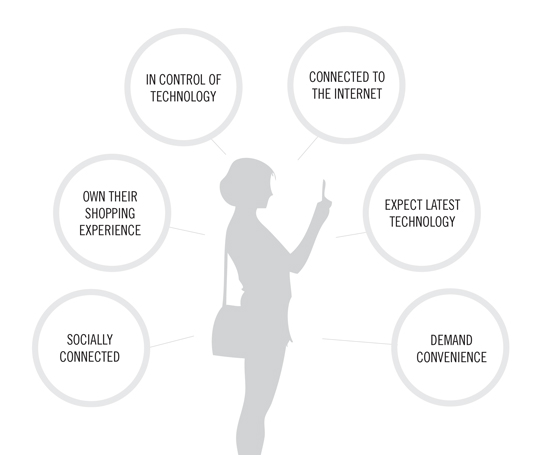
Social media has also played a major role in the rise in importance of the connected consumers. Consumers have taken to posting about their grievances on the social media pages of the companies as well as tagging them when posting complaints on their own page. This results in the complaints getting much greater visibility and forcing the companies to take faster and effective steps to address those grievances. In the competitive landscape of the current business world, an organization can hardly afford to appear apathetic to its consumers’ complaints. Connected consumers on social media are ensuring that this remains the case.
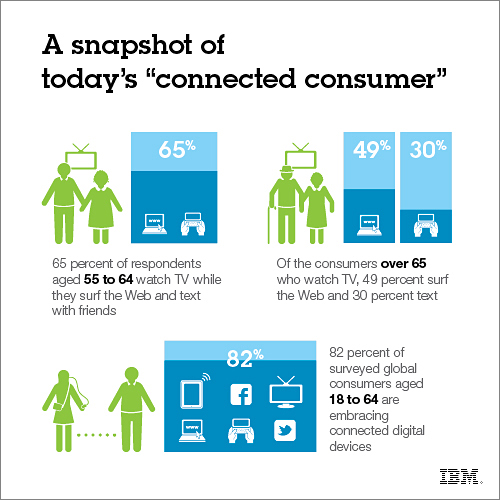
Connected consumers are much more vocal about their experience when dealing with a particular company. They are the ones who help form opinions on products and decide the fate of a product. When searching online for reviews and information on a particular product, it is their voice that gets heard first. As such, connected consumers have come to form a major segment of the how the retail industry forms its marketing strategy. And this is one factor that looks set to dominate the shape of the market for the foreseeable future.
Posted on July 17, 2015
 The smartphone market in India has been growing at an exponential rate over the last few years. Boosted by the availability of low cost smartphones by local manufacturers and Chinese companies, the Indian smartphone market has been witness unprecedented growth. Between 2013 and 2014, the market has grown by a staggering 260%, making it the fastest growing smartphones market in the world. Accompanying this growth, the mobile apps market is also growing steadily. According to Yahoo, the global app usage has been outpaced by app usage in India, which has grown by 131%.
The smartphone market in India has been growing at an exponential rate over the last few years. Boosted by the availability of low cost smartphones by local manufacturers and Chinese companies, the Indian smartphone market has been witness unprecedented growth. Between 2013 and 2014, the market has grown by a staggering 260%, making it the fastest growing smartphones market in the world. Accompanying this growth, the mobile apps market is also growing steadily. According to Yahoo, the global app usage has been outpaced by app usage in India, which has grown by 131%.
Research on the portable device market in India has shown that this huge spurt in growth is mostly due to the rise of online shopping in general, and m-commerce in particular. Ecommerce has been replaced by m-commerce with all the major online retailers coming out with apps available on all the leading platforms. Myntra, is now solely operating through its mobile app, while Flipkart no longer supports browsing its website through mobile phones, and prompts consumers to use the app instead. The other two major ecommerce sites – Amazon and Snapdeal – also have mobile apps. To attract consumers to shop through the apps, the retailers are offering additional discounts and offers on purchases made through the app.
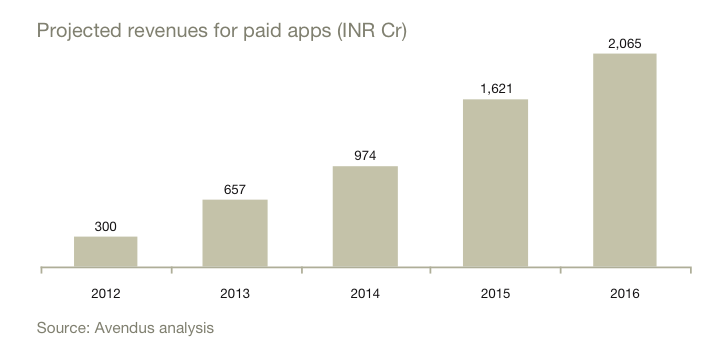
Another major reason behind the growth of the mobile apps market in India is the predominance of large screened devices. Research on the Indian smartphones market revealed that phablet market in India is growing at a faster pace than in the USA. Larger screens make it easier for people to use the apps. In fact, smartphone users in India spend 19% of their device using time on the apps, a number that comes second only to gaming at 25%. Personalization, News and Photography are occupy the top three spots in app usage.
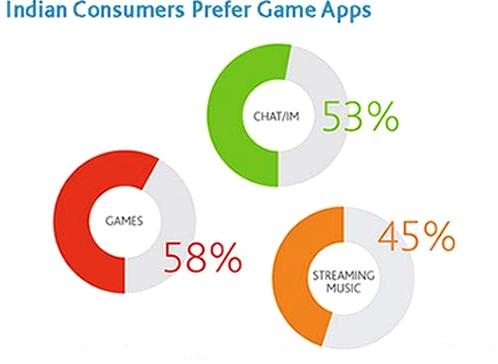
Taking advantage of the huge mobile apps market in India, companies are investing increasingly in mobile ads. Between 2013 and 2014, the volume of mobile ad grew by 260%. Simple banner ads are the most commonly used ones; although there has been an increase in using sophisticated and richer ads. Around 27% of the total revenue is generated by the media rich ads, even though they account for less than 4% of the total impressions. Increased investment in mobile ads has also solved one of the biggest problems of the Indian app market, that of developers earning money from their apps.
Huge potential, high growth rate and increased investment - the Indian app market seems to have hit a purple patch. The onus is now on the app developers to make the best of this and ensure that the journey on the upward trajectory continues for the foreseeable future.
Posted on July 10, 2015
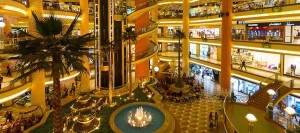 As far as online shopping is concerned, Egypt holds the biggest market share in MENA. As more customers realized the benefit of eCommerce shopping, especially of brands like Ralph Lauren which was otherwise available at inflated rates, online shopping industry dominated the region. As per market research reports, the Egyptian eCommerce market is expected to reach USD 2.7 billion by 2020, almost double of USD 1.4 billion in 2014.
As far as online shopping is concerned, Egypt holds the biggest market share in MENA. As more customers realized the benefit of eCommerce shopping, especially of brands like Ralph Lauren which was otherwise available at inflated rates, online shopping industry dominated the region. As per market research reports, the Egyptian eCommerce market is expected to reach USD 2.7 billion by 2020, almost double of USD 1.4 billion in 2014.
Mobile dominating offline shopping in MENA
This recent awareness regarding shopping in MENA region also gave rise to a new discovery - how the shoppers are using the internet even while offline shopping. With consumers now having access to checking the price of almost all the items in a store, compare it against the brick and mortar retailers, retailers expect that soon more than 90% of shoppers with access to mobile would rely on browsing to check prices and verify the product reviews. This research on Egyptian retail market has in fact suggested opportunities for in-store advertising based on their understanding of consumer behavior.
Even with all major brands existing in the malls of Egypt, why this preference for online shopping?
Preferring online over offline
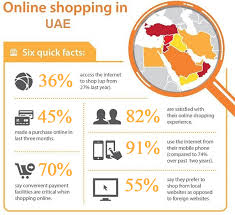
Most of the products available in Egypt have inflated prices compared to other countries. Furthermore, the online portals, for example, Yashry.com (one of Edfa3ly’s venture) offers products with about 50% of discount compared to the local prices, making the portals the preferred choice for purchasing. As per market research on Egypt, market experts are predicting positive growth, with websites witnessing as much traffic as their offline competitors. However, with online shopping, the consumers too have raised the bar for product delivery and services. Currently, websites selling home appliances and electronic products receives the highest levels of traffic, closely followed by music sites and computer software downloads. Clothing, accessories, hotels, restaurants and food delivery websites follow closely.
It was found that more than 84% of respondents would check the reputation of the website along with price or value of the item. Furthermore, their buying decision would also depend on the availability of payment options. However, besides these benefits, online shoppers in Egypt face numerous obstacles, especially the lack of credit cards that work overseas, and orders not being dispatched or received.
Even though the eCommerce market is slated to grow 24% to 45% annually, there are still many obstacles like low credit card penetration rate, with only 2% of Egyptians owning credit cards. Along with this, there is also lack of awareness regarding online shopping with consumers still being wary of trusting local couriers with deliveries.
As the economy finally stabilizes in Egypt after three years of social and political unrest, market research predicts that Egypt will see a high growth rate in the eCommerce market. Instead of depending on over-crowded, over-priced and poorly ventilated shopping malls, market vendors are seeing that virtual malls would give Egyptian shopper easier access to the international marketplace.
Posted on July 7, 2015
 Today, the shoppers are looking for high quality, attractive and consumer-ready food that come with a long shelf life. Accepting exotic tastes and eager to try out the newer varieties, the shoppers are prepared to even pay a little extra in exchange for preparations that are safe and have a long life. In order to meet these demands, the food sector need to constantly deliver fresh, and quality food. Certain segments of the catering industry often employ production to order to satisfy the demands of their patrons but then these can result in a very expensive operation. The solution therein lies in efficient production and packaging that would guarantee taste, appearance and food safety along with longevity.
Today, the shoppers are looking for high quality, attractive and consumer-ready food that come with a long shelf life. Accepting exotic tastes and eager to try out the newer varieties, the shoppers are prepared to even pay a little extra in exchange for preparations that are safe and have a long life. In order to meet these demands, the food sector need to constantly deliver fresh, and quality food. Certain segments of the catering industry often employ production to order to satisfy the demands of their patrons but then these can result in a very expensive operation. The solution therein lies in efficient production and packaging that would guarantee taste, appearance and food safety along with longevity.
Therefore, one of the most important things in preserving food throughout the distribution chain is food packaging according to research on the food and beverage sector. Food can become contaminated with direct contact with any physical, chemical or even biological elements. In the recent years, novel food packaging has proven to not only increase the shelf life of food but also their safety and quality to a great extent.
Challenges to food packaging
 However, despite the benefits, pre-prepared and catered food also presents a complex challenge. Most of these have mixed ingredients that increase their potential for deterioration, which makes them difficult to pack. To cite an instance, if ravioli and lasagna contains meat, it would spoil at a different rate than the regular pasta. Spoil is another concern, which is caused by microorganisms leading to rancidity, discoloration, stale food and loss of taste. This makes it important to get the right combination of carbon dioxide and nitrogen balance. This balance would also depend on moisture content of food and composition of different ingredients, as they can significantly influence the speed of the growth of microbes.
However, despite the benefits, pre-prepared and catered food also presents a complex challenge. Most of these have mixed ingredients that increase their potential for deterioration, which makes them difficult to pack. To cite an instance, if ravioli and lasagna contains meat, it would spoil at a different rate than the regular pasta. Spoil is another concern, which is caused by microorganisms leading to rancidity, discoloration, stale food and loss of taste. This makes it important to get the right combination of carbon dioxide and nitrogen balance. This balance would also depend on moisture content of food and composition of different ingredients, as they can significantly influence the speed of the growth of microbes.
Market experts of food and beverage sector suggest using modified atmosphere packaging (MAP), wherein the food is heated externally by pressurized water, and internally by a patented microwave system. This helps in making the food reach its sterilization temperature, reducing process time and heat damage. This process also improves quality and ensures retention of nutrition in the food. Furthermore, US FDA approves this microwave sterilization technique.
Implementing intelligent packaging methods reduces food waste
 As per EU, the main causes for food waste are inadequate packaging, confusion regarding “best before” and “use by” labels along with consumer’s lack of awareness, overproduction, inadequate storage and stock management inefficiencies. About 90 million tons of food is wasted annually in Europe, and about a third of the food is wasted globally, which means 1.3 billion tons every year. As per the European commission’s research on food and beverage industry, 40% of the above mentioned food wastage happens at the retail and consumer level and if no action is taken, the waste generation is expected to reach 126 million tons every year by 2020.
As per EU, the main causes for food waste are inadequate packaging, confusion regarding “best before” and “use by” labels along with consumer’s lack of awareness, overproduction, inadequate storage and stock management inefficiencies. About 90 million tons of food is wasted annually in Europe, and about a third of the food is wasted globally, which means 1.3 billion tons every year. As per the European commission’s research on food and beverage industry, 40% of the above mentioned food wastage happens at the retail and consumer level and if no action is taken, the waste generation is expected to reach 126 million tons every year by 2020.
This data showed that usage of active technologies such as oxygen and ethylene scavenging, anti-fungal and anti-microbial, humidity control and anti-oxidants etc. and traceability indicators would benefit the whole supply chain. Furthermore, consumer behavior – such as weekly purchase rather than daily shopping and more single person units – would be more suited for the kinds of requirements that active packaging offers. Research has shown that active packaging doubles the shelf life of many perishable products compared to conventional packaging methods, for the smart packs also states the condition of the product and it does not call for best before labels.
Food manufacturers rising to the challenge
 With the market being driven by the demand for fresh, better quality packaged food in convenience packages, food manufacturers are increasingly becoming concerned about methods that would help them increase product shelf life. Even though smart and active packaging technology has been around for a while, it too is seeing rapid changes. MAP and vacuum skin packaging are becoming increasingly popular. As food manufacturers rise to the challenge of sustainability, they are even using methods like oxygen scavenging packaging to increase shelf life that would use natural components. These manufacturers are also using bio-based plastics made from sugarcane waste, shrimp shells and other materials as their packaging materials, enabling them to launch shelf-stable products that reach larger markets and distribution channels without deteriorating in any way.
With the market being driven by the demand for fresh, better quality packaged food in convenience packages, food manufacturers are increasingly becoming concerned about methods that would help them increase product shelf life. Even though smart and active packaging technology has been around for a while, it too is seeing rapid changes. MAP and vacuum skin packaging are becoming increasingly popular. As food manufacturers rise to the challenge of sustainability, they are even using methods like oxygen scavenging packaging to increase shelf life that would use natural components. These manufacturers are also using bio-based plastics made from sugarcane waste, shrimp shells and other materials as their packaging materials, enabling them to launch shelf-stable products that reach larger markets and distribution channels without deteriorating in any way.
Posted on July 2, 2015
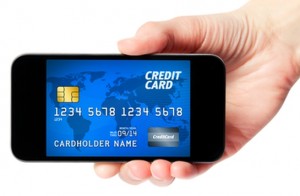 Mobile wallets take the help of near-field communication (NFC) chips inside smartphones and tablets to transmit payment information. Users can securely store their personal information in organized form on their smartphone. With the unprecedented rise in the use of smartphones, mobile wallets are also witnessing increased adoption across geographies. Some examples are Google Wallet, the Apple Pay, and Orange and Barclaycard, and Visa initiatives in the UK.
Mobile wallets take the help of near-field communication (NFC) chips inside smartphones and tablets to transmit payment information. Users can securely store their personal information in organized form on their smartphone. With the unprecedented rise in the use of smartphones, mobile wallets are also witnessing increased adoption across geographies. Some examples are Google Wallet, the Apple Pay, and Orange and Barclaycard, and Visa initiatives in the UK.
As per research on mobile wallets, mobile payments is expected to top USD 720 billion by 2017, from USD 235 billion in 2013. Tech companies are rapidly making moves to control the influx of bits and cash across several million smartphones across millions of online and physical locations. The increased adoption of these mobile wallets has led the perception of the platform to thereby change from being only a tool of payment to that of a customer engagement one. To cite an instance, Ebay’s PayPal division has upgraded its entire technology platform, and launched a complete new mobile payment app. In fact, it is pushing to place its Beacon sensors in millions of shops to augment the power of hands-free digital payments.

The other platforms, too, are not just watching. For example, Google has gone on board with some partners to build its market share in mobile wallets. AT & T, T-Mobile and Verizon would now pre-load Google’s app on certain mobile handsets. These companies have allowed Google to be in control of Softcard, the alliance they created to control their mobile payment destiny.
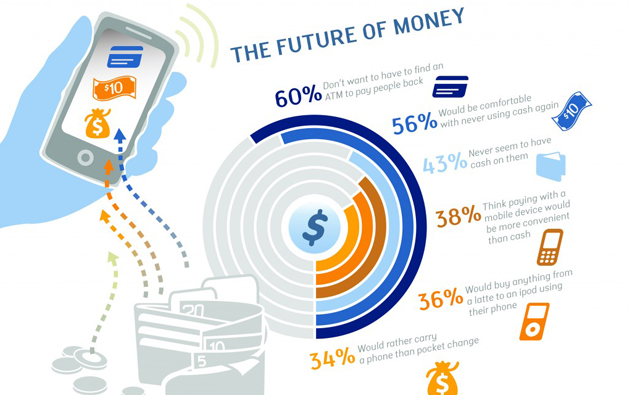
However, as per market research on mobile wallets, to understand what the future holds for online payment gateways, it is important to look at Starbucks. The mobile app of Starbucks is one of the most used digital payment apps in America. About 10 million customers are paying for their lattes with the app, making more than 5 million transactions per week. As per Starbuck’s Chief Digital Officer, Adam Brotman, this app has in fact enhanced the experience and relationship with the customer. On the other hand, cynics of this platform think that replacing credit cards and cash with a phone tap is just “technology for technology’s sake.” To ensure its growth, and for mobile money to really take off, it must offer more. PayPal President David Marcus thinks that the platform has to offer experience that consumers receive online today. He said, “You’ll get what you want really fast, pay really fast and get out. And the merchant will know more stuff about you, and that will make your experience better.” (How to Win the Mobile Wallet War)
While consumers look forward to speed through checkout lanes with mobile wallet payment, there are still things that need to be improved. Drawbacks like only enabling purchases from retailers with POS terminals, lack of royalty or reward programs from brands, or even safety concerns has led to slowing down of its adoption. To ensure its adoption by businesses and use by customers, mobile wallet platforms should integrate advanced analytics, and big data capabilities with robust security elements. Despite all these challenges, by 2018, the adoption of mobile wallets is expected to reach 15-20% of smartphone users. This is an impressive upgrade.
So, would you chose mobile wallet payment to make your next purchase?
Posted on June 15, 2015
 As consumers become more aware of and concerned regarding health risks and obesity, the sports drinks market is expected to continue growing. However, most of these drinks are largely physical activity driven, making it an attractive product for consumption for only those who seek post work out refreshments and need to feel energized during exercise. Others mostly consume the product seeking association with their favorite athletes. These factors have actually led the sports drinks manufacturers to rope in such marketing techniques wherein these buying trends are exploited. However, the techniques, even if effective to a certain extent, fail to promote the drinking occasion outside of exercise or any sports related activities. However, there are markets wherein athletic and workout cultures are not as influential in beverage intake decision like in Indonesia. Here, the key players such as Pocari Sweat by Otsuka Holdings Co Ltd have been leveraging a youthful consumer base, changing lifestyles and warm climates to transform sports drink to an everyday drink.
As consumers become more aware of and concerned regarding health risks and obesity, the sports drinks market is expected to continue growing. However, most of these drinks are largely physical activity driven, making it an attractive product for consumption for only those who seek post work out refreshments and need to feel energized during exercise. Others mostly consume the product seeking association with their favorite athletes. These factors have actually led the sports drinks manufacturers to rope in such marketing techniques wherein these buying trends are exploited. However, the techniques, even if effective to a certain extent, fail to promote the drinking occasion outside of exercise or any sports related activities. However, there are markets wherein athletic and workout cultures are not as influential in beverage intake decision like in Indonesia. Here, the key players such as Pocari Sweat by Otsuka Holdings Co Ltd have been leveraging a youthful consumer base, changing lifestyles and warm climates to transform sports drink to an everyday drink.
Birth of the specialized sports drinks
The global sports drinks market has had its share of difficulties. In spite of being affected during the global recession period of 2007-09, as well as increased inspection on the sugar content of the drinks, economic recovery and product reformulations have revived the category long back. This recovery could be accredited to the introduction of sugar free or low calorie variations that helped remove apprehensions concerning sugar intake. With this, brands also developed specialized uses, like drinks formulated with vitamins and carbohydrates to fuel the body before a workout, or drinks with electrolytes for use during exercise. While the introduction of such drinks has actually done well to attract specific consumer segments, companies are also limiting their brand potential with narrow, sports focused campaigns. To cite an instance, even if there is a decline in the purchase of sugary carbonates, it is mainly due to health consciousness but it does not mean that buyers are training for marathons and would like drinks of that category only. So, while the health conscious consumers may pay a premium for performance beverages, positioning them like this does little to attract the average consumers who are just seeking day to day refreshments. Therefore, in order to stay relevant with core customers, performance must be emphasized upon. However, for attracting casual purchasers, taste, refreshment and convenience plays a major role. This is exactly what the Indonesian sports drinks market has worked upon.
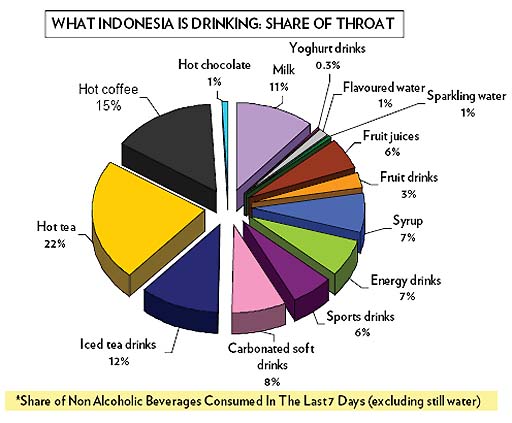
Sports drinks in Indonesia – fastest growing segment
In Indonesia, the sports drinks market is considered to be the fastest growing segment in the soft drinks category in terms of off-trade volume over the past few years. Sports drinks are the fifth most consumed beverage after bottled water, Asian specialty drinks, RTD tea and carbonates. The market share of sports drinks is more mainly because the manufacturers have been able to leverage the USP of the product to meet with the needs of Indonesians, thereby increasing sports drinks occasion and making the category popular among the consumer base.
Besides that, Indonesia has a tropical climate, which is characterized by high humidity and high temperatures. The climate has further made these on-the-go drinks like bottled water and bottled RTD tea along with sports drinks which is fortified with electrolytes and carbohydrates, a preferred choice among consumers. The manufacturers also have positioned these sports drinks as a more effective hydration system. For example, an Indonesian television advert for Mizone Active Hydration centers on an Indonesian office worker using the product to be at his 100% even at the office. The composition and look of these drinks also play key roles in their appeal to a broader consumer base. All these factors have ensured that the sports drinks category remains popular and is not stereotyped as a drink partaken of during exercise only.
Posted on June 5, 2015
 As the world gradually recovers from the effects of the recession, the defense industry and the aerospace industry are looking for ways to ensure that they stay ahead of the curve. Prior to the recession, the defense industry was a fast growing one. The aerospace industry had its problems, but it too managed to make the best of the available opportunities. However, with the economies of the world hit hard by recession, the prospects of both the industries have changed considerably. The hue and cry over defense expenditure has led governments of many European countries and the USA to cut down its defense budget. The high cost of plane fare during the recession hit the aerospace industry hard. Both the industries have recovered to some extent, but a lot of work is yet to be done. Currently, both the sectors are engaged in identifying their weak spots and take appropriate measures to ensure that they are capable of tackling any future financial crisis.
As the world gradually recovers from the effects of the recession, the defense industry and the aerospace industry are looking for ways to ensure that they stay ahead of the curve. Prior to the recession, the defense industry was a fast growing one. The aerospace industry had its problems, but it too managed to make the best of the available opportunities. However, with the economies of the world hit hard by recession, the prospects of both the industries have changed considerably. The hue and cry over defense expenditure has led governments of many European countries and the USA to cut down its defense budget. The high cost of plane fare during the recession hit the aerospace industry hard. Both the industries have recovered to some extent, but a lot of work is yet to be done. Currently, both the sectors are engaged in identifying their weak spots and take appropriate measures to ensure that they are capable of tackling any future financial crisis.
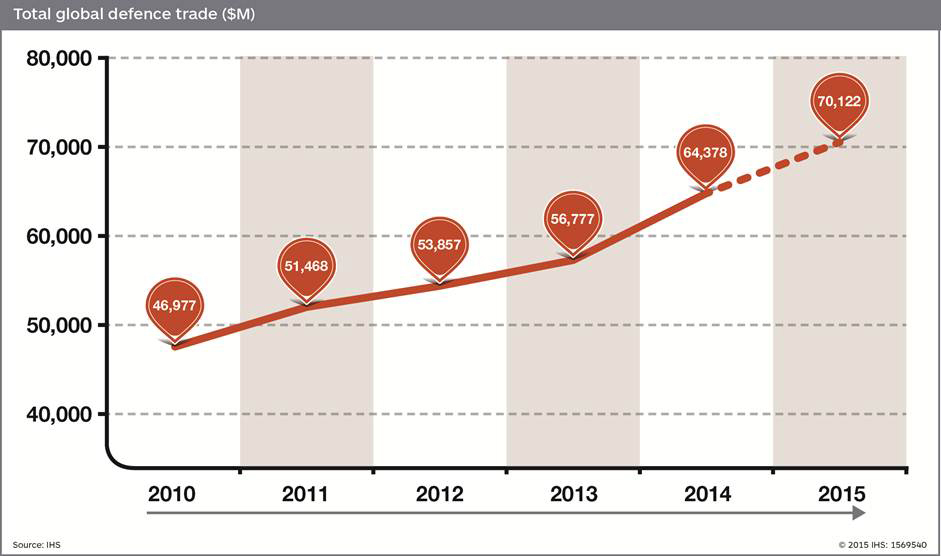
For the defense industry, the first step has been to identify sectors in R&D that can be dispensed with, and those which need increased focus. This can ensure that vital resources are not wasted over something that cannot ensure sufficient return. Streamlining the R&D process will also help in reducing the turnaround time and help the manufacturers get the competitive edge. Partnering with suppliers is another path that the defense industry is likely to follow in the near future. It will increase affordability while ascertaining the timely delivery of products. However, the best bet for the defense industry is to focus on the markets in the developing countries- especially the markets in Brazil, China, and India. All these countries are spending heavily on defense equipment and as such provide an alternative to the shrinking market in Europe. As a matter of fact, while the USA is reducing its budget for homeland security, India has been the leading importer of arms for the past couple of years.
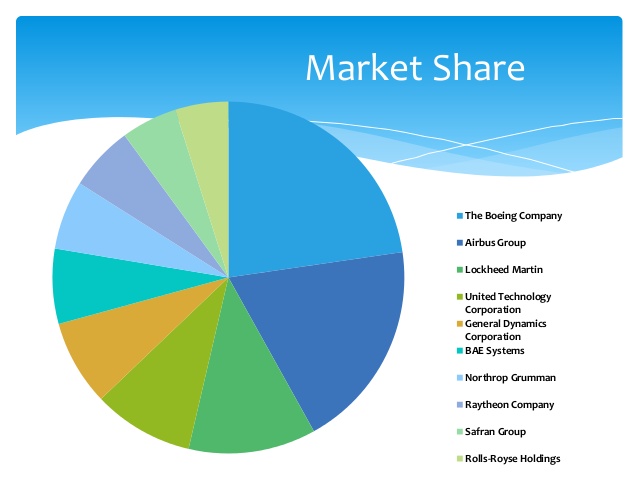
The aerospace industry, while going through a favorable patch, is looking for ways to improve its supply chain and manufacturing processes. As things stand now, the manufacturing backlog is terrible and given the increased demand, this can spiral out of hands if steps are not taken immediately. Further integration of digital analysis is another way in which the aerospace industry is trying to change its mode of operation. Digital analysis of the aircraft can provide with details regarding necessary maintenance activities well in advance; thus, reducing down time significantly.
The face of the defense industry as well as the aerospace industry is all set to change. Newer modes of operation combined with opening up of new markets will directly result in adoption of new strategies and policies. Whether the changes can be implemented in time to save the industries from any further fiasco is what the business world is keeping an eye on.
Posted on June 2, 2015







































